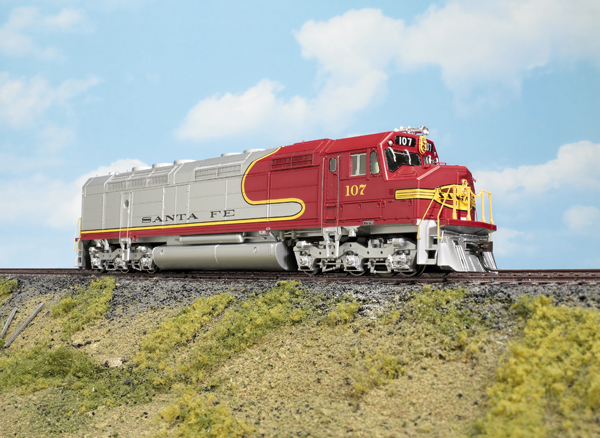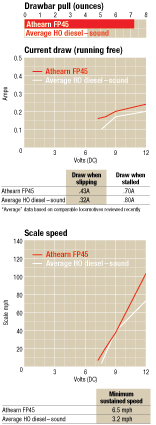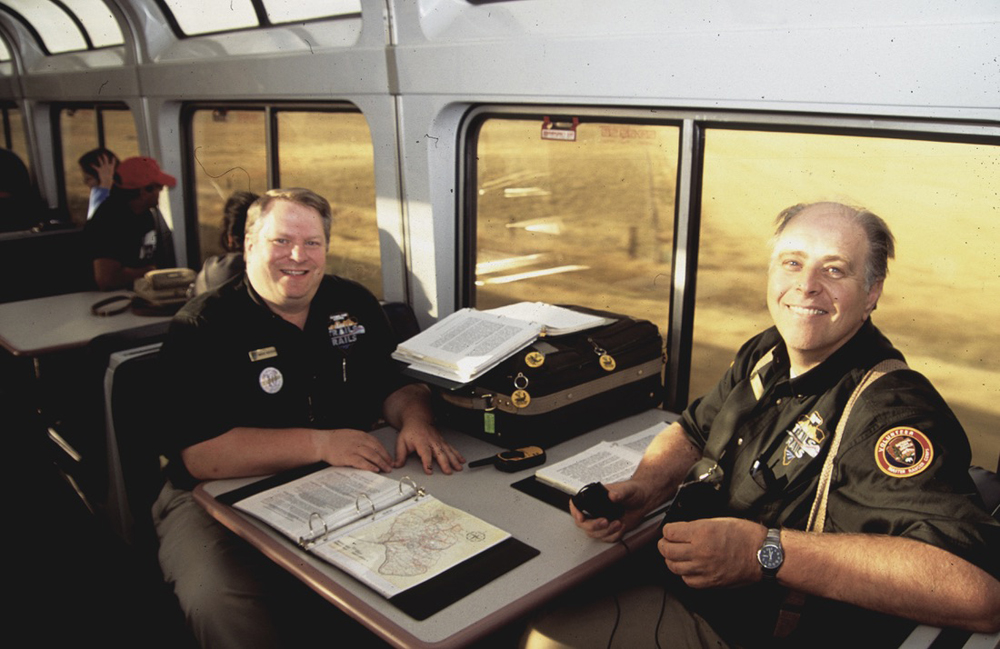Equipped with onboard sound and Digital Command Control (DCC), the newest offering from Athearn’s Genesis series is also a treat for detail fanatics, with etched-metal grills, see-through fans, and scale-width wire grabs.
Designed by request. In the mid-1960s, the Atchison, Topeka & Santa Fe wanted a new locomotive with a fully enclosed body to head up the Super Chief and El Capitan. Though contemporary hood units such as the SDP45 had the power for the job, the Santa Fe wanted an engine with a more streamlined look for its crack passenger trains. In 1967, EMD delivered the first nine FP45s, painted in the Santa Fe’s red, silver, and yellow passenger warbonnet scheme.
The Milwaukee Road ordered five units without dynamic brakes, planning to use them in Hiawatha service. After the advent of Amtrak in 1971, both roads repainted the locomotives in freight schemes and removed their steam generators.
In addition to the FP45 in Santa Fe and Milwaukee Road passenger colors, Athearn is also offering an F45 without a steam generator, painted both in the Santa Fe’s freight scheme and in the Great Northern’s Big Sky Blue colors. The Great Northern bought 14 of the freight engines in 1969.
Our test sample, Santa Fe FP45 no. 107, came equipped with a DCC sound decoder. The locomotive is also available as a direct-current model with an eight-pin socket for upgrading to DCC.
Details, details. Athearn’s FP45 looks great, with wire and etched-metal parts enhancing the meticulous detail molded into the one-piece plastic body. The model matches the dimensions of a prototype drawing in the Model Railroader Cyclopedia Vol. 2: Diesel Locomotives, (Kalmbach Books, out of print), down to the lift ring positions and the weld seam in the divided fuel-and-water tank.
I particularly appreciated the factory-applied wire grab irons, which are a close-to-prototypical 0.6 scale inches thick. The Celcon handrails on the front and back porches are, by necessity, a little thicker, but still close. The photo-etched rear air intake and fan grills are also quite impressive, as are the lift rings. The paint stripes and lettering are crisp and vivid.
I tested our sample in DC mode first. As with any sound-equipped locomotive, the power requirements of the sound system give the engine a fairly high starting voltage. The sound system kicked in at 5.5 volts, warming up to an idle. With increased voltage, the engine sound cycled up appropriately, until the locomotive started moving at 8 volts. At that voltage, the locomotive took off at a scale 20.3 scale mph – high for a starting speed. As my tests went on and the motor and gearboxes had a chance to break in, the model’s performance improved, starting at 7.25 volts with a scale speed of 6.5 mph.
Running at 12 volts DC, the locomotive reached 103.3 scale mph, close to the prototype’s top speed of 102 mph.
When operating on DCC at 28 speed steps, the engine didn’t start rolling on its own until step 4, moving at 13.9 scale mph. After I changed the decoder’s starting voltage (CV2) setting to 1, the engine responded at speed step 2, rolling at a respectably slow 5.2 scale mph. At speed step 28, the engine flew down the tracks at a scale 121.3 mph, a good bit faster than the prototype.
The model also performed well using 128 speed steps, starting at 6.25 scale mph on speed step 5.
The locomotive’s most impressive feature is its power. The model weighs in at a solid-feeling 1.75 pounds. Combined with all-wheel drive, that weight contributes to an equally hefty pulling power of 7.2 ounces. That’s enough to haul 100 standard HO scale freight cars on straight and level track.
Sound system. The locomotive comes with a remote to play sounds under DC. With it you can activate the bell, the horn, a coupler-crash sound, dynamic brake, and lighting effects.
A thoughtful touch about the sound system is that when the dynamic brake is turned on, the motor noise running below it drops to idle speed, just as it would on the prototype.
The DCC decoder and the 1″ speaker rest in recesses in the top of the metal frame. Though they are otherwise unsecured, the engine compartment is so fully packed that they don’t move around. There was no audible buzzing or rattling when the engine was rolling.
Solid performer. The FP45 came on the scene during the last days of Class 1 railroad passenger service in the United States. If you want to capture those glory days with one of the nation’s most famous name trains, the Athearn FP45 is a great start.
Price: Direct current $139.98,Digital Command Control and sound $239.98
Manufacturer
Athearn Trains
1550 Glenn Curtiss St.
Carson, CA 90746
www.athearn.com
Description: Ready-to-run plastic and metal HO scale diesel locomotive
Paint schemes: FP45 (with steam generator): Atchison, Topeka & Santa Fe (passenger warbonnet scheme, road numbers 100, 105, and 107); Milwaukee Road (yellow and gray, numbers 1, 2, and 5); and undecorated (with or without dynamic brakes). F45 (no steam generator): ATSF (blue and yellow freight scheme, nos. 1928, 1936, and 1939); Great Northern (Big Sky Blue, nos. 427, 430, and 439); and undecorated (with or without dynamic brakes)
All-wheel drive and electrical pickup
Blackened metal RP-25 contour wheels in gauge
Detailed cab interior
Direct-current (DC) or dual-mode Digital Command Control (DCC) with onboard sound
Etched-metal grills and lift rings
Five-pole, skew-wound motor with dual brass flywheels
McHenry magnetic knuckle couplers at correct height
Radio remote control for sound activation of DCC model running in DC mode
Scale-thickness wire grab irons















